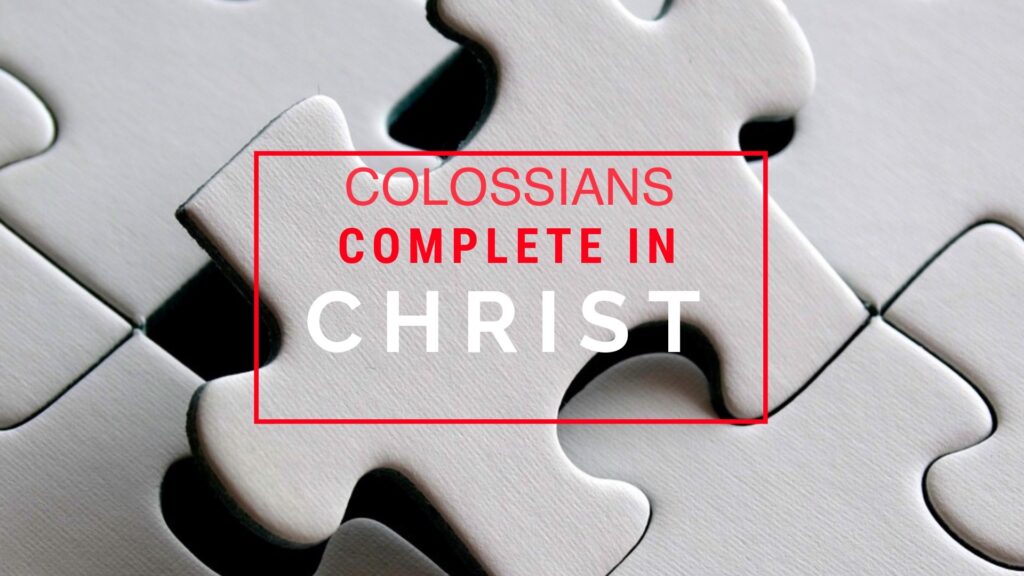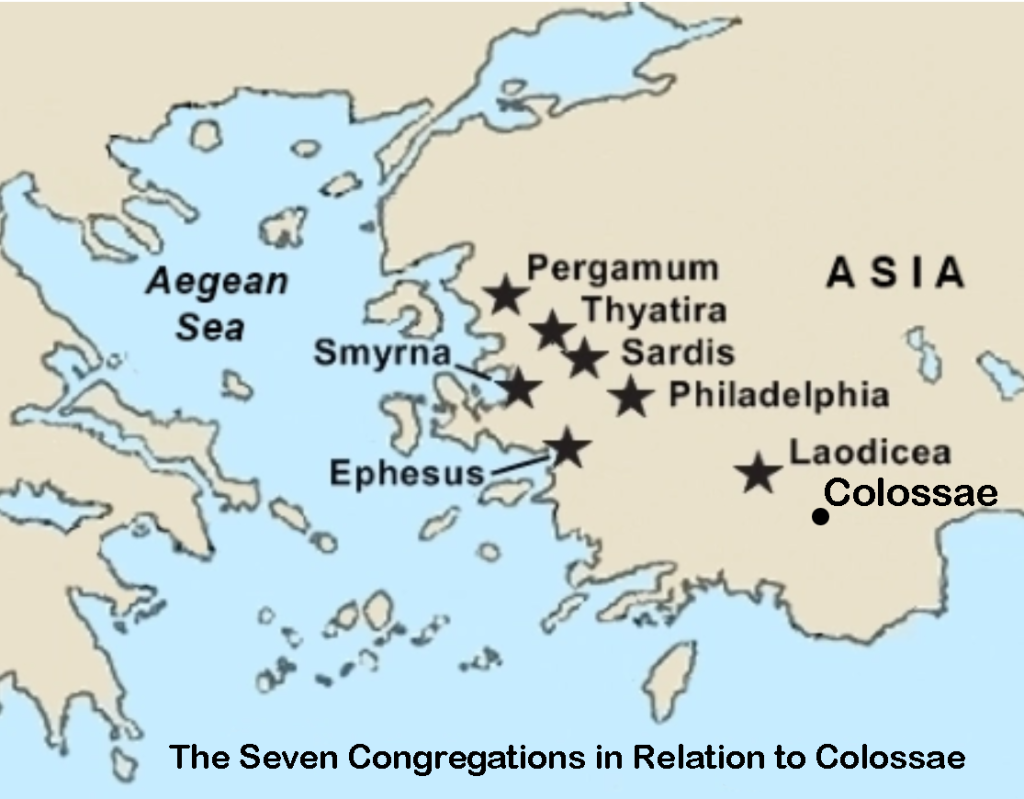
Introduction to the sermon series
Today “wholeness” and “holistic” are buzz words, but in the Epistle sent by the Apostle Paul to the church at Colossae in ancient times the Gospel of Jesus was explained in these very terms. The same Jesus who claimed to the “…the way, the truth and the life…” (John 14:6) and who came to give “…life in abundance” (John 10:10) is the basis in the Christian life for fulness of life as God intends it.
Paul wrote, “…we have not ceased praying for you and asking that you may be filled with the knowledge of God’s will in all spiritual wisdom and understanding, so that you may lead lives worthy of the Lord, fully pleasing to him, as you bear fruit in every good work and as you grow in the knowledge of God” (Col. 1:9,10). His confidence in God came from Christ, in whom “…the fulness of God” dwelled (Col. 1:19; 2:9), and by whom God “…rescued us from the power of darkness and transferred us into the kingdom of his beloved Son, in whom we have redemption, the forgiveness of sins” (Col. 1:13,14).
Paul applies the impact of the fulness of God in Christ to the full and complete life Christians are promised in all facets of life: personal relationships, congregational life, and the marketplace in this positive and life-affirming Epistle in the New Testament.
4 Sept 2022 #1 What grace looks like in action Colossians 1:1-14 Youtube
11 Sept 2022 #2 All God has to offer Col. 1:15-23 Youtube
18 Sept 2022 #3 Making maturity our goal Col. 1:24 – 2:5 Youtube
25 Sept 2022 #4 Staying Alive Col. 2:6-23 Youtube
2 Oct 2022 #5 Connecting Heaven on Earth in the Church Col. 3:1-17 Youtube
9 Oct 2022 #6 Connecting Heaven on Earth in Daily Life Col. 3:18-4:18 Youtube Text
Introduction to the Letter to the Colossians
Colossae & Carlton may have some similarities. Think of the diversity of people at the Vic market, life along the river at Southbank, students of the arts Brunswick St, off to the hot springs at Daylesford for the weekend. Think of the range of nationalities and religious and superstitious beliefs held by the people you would meet.
Colossae is in modern day Turkey. It’s a region that Alexander the Great conquered and acquired from the Persian Empire and goes right back to the Hittite domination. In its last handover before the time of the New Testament, the last king of Pergamum died with no heirs. Being faithful allies of Rome, this area of Asia Minor or Western Anatolia was put under the authority of a Roman proconsul in 133 B.C.
The region is about 160km east of Ephesus near modern day Denizli in modern Turkey.

Laodicea is just down the road and is famous for its wealth and prosperity. It is, of course, most known to us for its ignominious mention in Revelation. Can you recall what comment is made about that church in the Book of Revelation?
Heirapolis (holy city) is near by also. It is famous as the birthplace of the great Stoic philosopher Epictetus. The chief industry in these cities was the manufacture of woolen fabrics (not quite Australia’s primary industry anymore). These cities remained basically Hellenized, Greek in culture, under the Roman rule. Jewish people in these regions enjoyed the privileges given to many under Roman rule and experienced a reasonably tolerant inclusion. This area once known as Phrygia was so influenced by Jewish culture that the story of Noah was taken over as a cult legend at a place called Apamea. People from Phrygia are included in the list of those present at Peter’s speech on the Day of Pentecost recorded in Acts 2.
Later, during Paul the apostle’s Ephesian ministry (AD 52-55) Acts 19:10 tells us “all the residents of Asia heard the word of the Lord, both Jews and Greeks”. Colossians 2:1 seems to indicate that Paul did not evangelize the Lycus valley itself for he was not personally acquainted with many there. However, Philemon seems to be a convert of Paul’s from Colossae (19b) and Epaphras appears to have been preaching and church planting there (Col. 1:7; Phil 23). He is Paul’s “fellow-slave” and “fellow-prisoner”. It is quite reasonable to believe that the Colossians were among those the Apostle John wrote his letters to among the churches of Asia Minor. It is understood that the 3 towns shared in a mutual prosperity of wealth. However, they could equally have shared the warning given in Revelation 3:14-22.
Laodicea was located between Heirapolis with its medicinal hot springs, and Colossae with its refreshing supply of cold water which gushed down the mountain before reaching Colossae. The city of Laodicea had no water of its own. This was a great weakness. If a city was to prosper it had to have its own water source.
However, Colossae’s water was life giving and refreshing. It was received straight from the source. Laodicean’s built an aqueduct to receive Colossae’s water. This helped Laodicea grow and gain wealth. As Laodicea expanded, Colossae began to decline. Colossae’s water was transferred to Laodicea through a 15 km long tube. Close to Laodicea was the city of Hieropolis. Hieropolis contained a natural hot spring which was excellent for healing and medicinal purposes. However, by the time the hot water arrived in Laodicea it was lukewarm and polluted (the same description given to faith in this area by the end of the 1st century). The Apostle Paul was so worried about the dilution of the Gospel in that region that in 2 Tim. 1:15 he states “you are aware that all in Asia are turning away from me”.
Paul’s departing speech given to the Ephesian elders in Acts 20:29-30 hints at an onslaught of invading philosophies and teachers that would come and draw people away from the Gospel. However, beyond our letter there are heroes of the faith that established orthodox Christianity in the Lycus valley for the next 4 centuries.
Philip the evangelist in the first century (Acts 21:8-14) and some of his four prophesying daughters had a great influence and their tombs are located in Hierapolis.
Ignatius, bishop of Antioch in the second century passed through Asia Minor. A follower of John, called Papias was a contemporary of
Polycarp was once bishop of Smyrna and he was a writer of doctrine. And so the list goes on in history to the point that in AD 363 the churches of the region produced sixty rules called the Canons of Laodicea which later became very important matters for church order across the empire.
We get the impression from history that this letter was tackling the beginnings of Christianity in a foreign and difficult culture. From Persian and Greek influences in the past, this was not the most fertile soil for understanding the person of Jesus Christ. Paul shows in Colossians 4:16 that he wanted the letter read more broadly than just at Colossae. Indeed God has made this letter a letter for all Christians to heed.
A quick study on the Letter to the Colossians
Discuss in pairs the following questions. You’ll need a bible between you or refer to the texts on the handout:
•What the Colossians used to be like? (1:21; 2:13)
•What they are now like? (1:3-8)
•What is Paul’s situation?(4:3,18; Philemon 23)
•What “heresy” or divergence from the original teachings of Jesus and the Apostles seems to be present? (see 2:8-10, 16, 18, 20-23)
Here follows some notes from comments made by students of the text…
•No external, detailed evidence of the heresy exists, only what is written here and inferred in Ephesians
•The Colossians being criticized by Paul were not quite “Gnostics”, not quite “Judaizers”
•Paul aims to have his readers avoid a gospel minus something (2:8,9) and a gospel plus something (2:16,17)
•Such a need for staying true to the Gospel of Jesus is a perpetual challenge to address
Heresy Exposed?
Col 2:4 “I tell you this so that no one may deceive you by fine-sounding arguments.”
Col 2:8-9 “See to it that no one takes you captive through hollow and deceptive philosophy, which depends on human tradition and the basic principles of this world rather than on Christ. For in Christ all the fullness of the Deity lives in bodily form,”
Though we have no detailed evidence as to the nature of the heresy at issue in Colossae, the following factors can be gleaned from the text:
- The new teaching Paul warned against offered a spiritual “fulness” not previously experienced (2:10). Maybe “fulness of life” became one of their slogans. Paul writes to remind them of the and fulness of God in Christ.
- Secondly, the new teaching promised “freedom” such that Paul has to remind them of the deliverance that is their already in Christ (1:13, 2:15). The libertine approach promised by the teachers may turn out to be “slavery” according to Paul (2:8, 18, 20ff.)
- Thirdly, they suggest that special knowledge can proved protection from and power over the spiritual realm. Maybe a hint of spiritual elitism is developing. Paul addresses the uniqueness and supremacy of Christ over all powers and authorities (2:10, 15).
- They seemed to promote an impressively ascetic lifestyle designed to lead one to spiritual heights (2:18, 23). Paul sets out to distinguish between what is completely ours in Christ and what we must seek further (1:9-14).
- They created division and disunity. Colossians is a letter calling for Christian unity (2:1-5; 3:9-17) centred in Christ who is supreme and sufficient for us.
The main problem at Colossae could be described in this way: Some of their heretical views lay in the fact that they subtracted something essential from the Gospel message, e.g. The divinity and Lordship of Christ. There were other heretical views that were about adding something as necessary to the Gospel for salvation, e.g. performing certain religious or superstitious rituals or religious acts to assure one of salvation.
Throughout our lives, these two heresies will distract us, potentially, from an orthodox faith:
Q. What are some examples of adding to/subtracting from the Gospel today?
- Some churches today demand that people add something to faith in Christ to make their faith “true”: e.g. full-immersion or re-baptism; speaking in tongues; exclusive leadership authority; certain ways of reading the bible
- Other churches today suggest that Christianity is not so much about Christ as it is just about helping people: e.g. social justice ministries as an end in themselves (neo-humanism)
The Central Teaching Theme of Colossians
Let’s start at the very beginning. Well, I mean in the very middle!
Colossians 2:6-7 summarize the main point of Paul’s letter and within them we find the important elements that Paul wants his readers to concentrate on. Let’s take them bit by bit…
Col 2:6-7 “So then, just as you received Christ Jesus as Lord, continue to live in him, rooted and built up in him, strengthened in the faith as you were taught, and overflowing with thankfulness.”
- “So then”- Paul’s aim is to present every person (especially Gentiles) “perfect in Christ” (1:28)
- “Just as you received”- “received” means to have a teaching passed on to you (e.g. 1 Cor. 15:1)
- “Christ Jesus as lord”- the word “Christ” is a title (Hebrew = Messiah) from Old Testament reference to the ruler or king of Israel meaning “anointed” or “chosen one”. “Lord” = master in common use but means so much more here (Col. 1:13-20). Napoleon, on his deathbed, reflected on the ultimate power of the sword and compared it to the ultimate power of Christ when he said, “I die before my time and my body shall be given back to the earth and devoured by worms. What an abysmal gulf between my deep miseries and the eternal Kingdom of Christ. I marvel that whereas the ambitious dreams of myself and of Alexander and of Caesar should have vanished into thin air, a Judean peasant, Jesus, should be able to stretch his hands across the centuries, and control the destinies of people and nations.”
- “continue to live in him”- As opposed to moving on to other beliefs and practices. Christ is the beginning, center, and end of all Christian growth and living. Not to be diminished, not to be added to. The heresy invading the Colossian faith-space was both subtracting from Christ’s Lordship (2:8-9) and adding extras that must be done to produce true Christianity (2:16,17).
- “rooted”- like a tree deeply embedded in the ground weathering all storms, so we are to be grounded in our relationship with the living Lord Jesus Christ
- “built up”- Like a building (usually a corporate image– this letter is addressed to Christians together, not to an individual alone e.g. Ephesians 2:20-22; 1 Peter 2:5)
- “strengthened in the faith”- that is, the same body of teaching they had received (Col. 1:4-6)
- “overflowing with thankfulness”- A sign of a true understanding of what Christ has done for us
THE COMPLETE CHRISTIAN
In groups, think of the features that make up the ideal and complete Christian person as a kind of identikit. Use the letter to Colossians, the Gospels, also Ephesians chapters 2 & 4, and 2 Peter 1:3-11.
- AW Tozer once said that people who are crucified with Christ have three distinct marks: They are facing only one direction, They can never turn back, They no longer have plans that are purely their own.
- Read summary of Dallas Willard’s treaties on Discipleship from “Spirit of the Disciplines”
